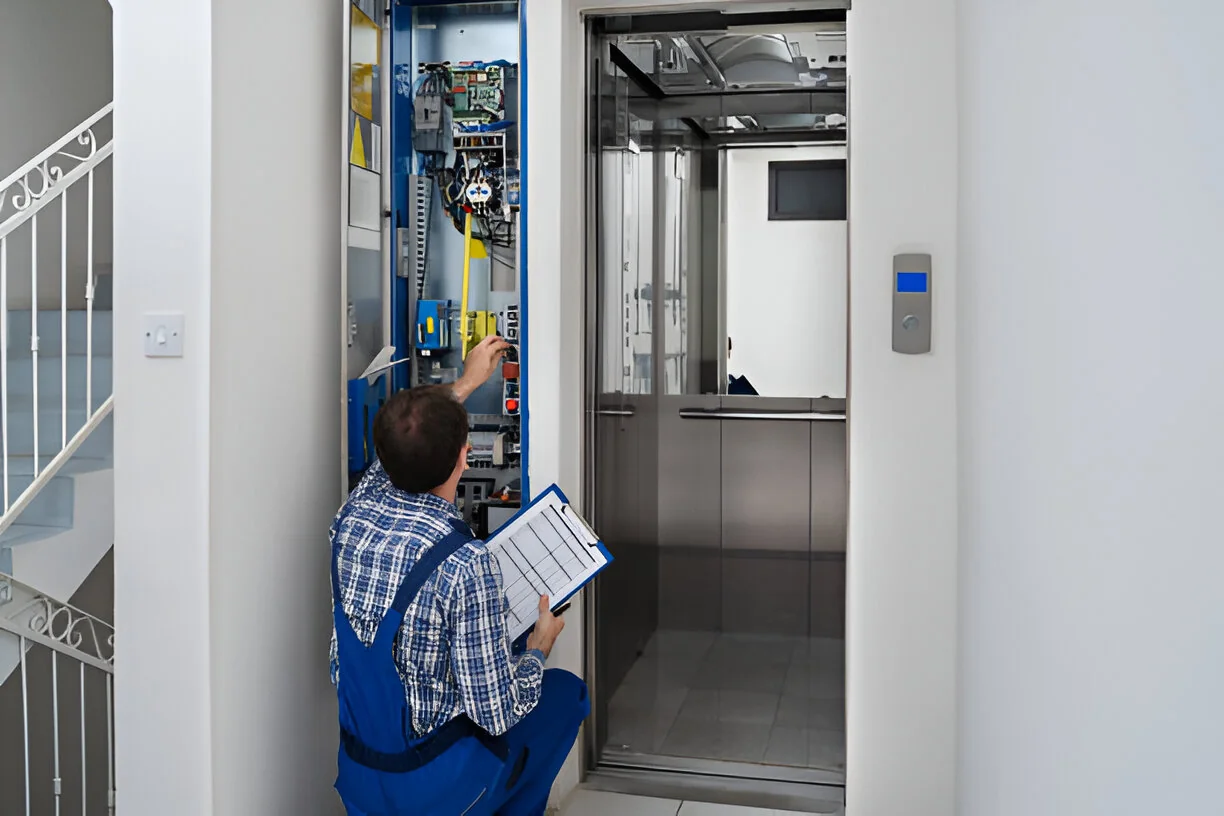In the world of building management, few things are as crucial yet often overlooked as elevator maintenance. As a building owner or manager, you may question the value of your elevator maintenance contract, especially if you’ve noticed a lack of service visits. This industry-wide issue is more than just an inconvenience it’s a ticking time bomb for your building’s operations and finances.

What are the Costs of Neglected Elevator Maintenance
The Elevator Consultants is hearing from all types of clients about their elevators being neglected when they have a service contract. Let’s dive into the true cost of neglected elevator maintenance and why it’s time to take action.
The Unseen Consequences of Skipped Maintenance
When elevator service providers fail to show up for scheduled maintenance, the repercussions extend far beyond a simple breach of contract. It should be noted that most contracts do not even state when the service provider will show up, leaving ambiguity. The long-term effects can be devastating to your building’s operations:
1. Increased Repair Costs: Regular maintenance prevents small issues from escalating into major problems. When routine checks are skipped, minor wear and tear can quickly turn into expensive repairs that should have been covered by your contract.
2. Reduced Equipment Lifespan: Elevators are complex machines designed to last for decades with proper care. Neglect can significantly shorten their lifespan, leading to premature replacement—a cost that can run into hundreds of thousands of dollars.
3. Safety Risks: Poorly maintained elevators pose serious safety issues to passengers. From malfunctioning doors to misleveling and others, these issues can result in injuries and potential lawsuits.
4. Decreased Property Value: A building with unreliable elevators is less attractive to potential tenants or buyers, directly impacting your property’s market value. It is the utmost embarrassing when someone comes to the building who is interested in renting and they see the elevator issues.
5. Energy Inefficiency: Well-maintained elevators operate more efficiently. Neglect can lead to increased energy consumption, driving up your building’s operational costs. It is believed that elevators are about 3-5% of the building’s energy consumption based on age and usage.
The Ripple Effect on Building Operations
The impact of unreliable elevators extends beyond the immediate mechanical issues:
- Tenant Dissatisfaction: In a multi-story building, functioning elevators are not a luxury—they’re a necessity. Frequent breakdowns or poor performance can lead to frustrated tenants and increased turnover rates.
- Productivity Losses: For commercial buildings, elevator downtime can significantly disrupt business operations. Employees waste valuable time waiting for elevators or taking stairs, impacting overall productivity. For other types of buildings like residential people get extremely frustrated because they cannot get to their destination in a timely manner. In a hospital situation, it can also be a life or death situation. There is numerous productivity losses based on the industry that the elevator is servicing
- Emergency Response Delays: In critical situations, such as medical emergencies, every second counts. Malfunctioning elevators can hinder first responders, potentially putting lives at risk. Delays of any kind be can be extremely frustrating. This can all be avoided by simply having proper elevator service maintenance.
- Compliance Issues: Regular maintenance is often required to meet local building codes and regulations. Failure to comply can result in fines and legal complications. It is the utmost frustrating for building to be paying for an elevator maintenance service contract and then to fail the local authority having jurisdiction inspections.
The Financial Reality: A Case Study
To better understand the financial implications of elevator maintenance (or lack thereof), let’s consider a specific scenario:
Imagine a building with two elevators, each 10 years old. The building pays $500 per month for elevator maintenance, totaling $6,000 per year or $60,000 over a decade. At first glance, this might seem like a significant expense. This is just a small unscientific yet realistic scenario of a building. However, let’s break down what this means for the building:
1. Investment Protection: A typical mid-rise elevator can cost between $190,000 to $300,000 to install. By paying $60,000 over ten years for maintenance, you’re investing just 20-40% of the initial installation cost to protect and extend the life of a critical building asset.
2. Preventing Major Repairs: Without regular maintenance, major repairs become more likely. A single significant repair, such as replacing a motor or a controller, can exceed several years’ worth of maintenance costs.
3. Avoiding Premature Replacement: Well-maintained elevators can last 20-30 years before needing replacement. Neglect can cut this lifespan in half. If poor maintenance leads to replacing the elevators just 5 years early, it could cost the building $300,000 – $600,000 in premature capital expenditure. We are seeing buildings replacing equipment in 10-15 years because of design and maintenance issues.
4. Liability Mitigation: The average settlement for an elevator-related injury can be anywhere from tens of thousands of dollars to millions. Regular maintenance significantly reduces the risk of such incidents, potentially saving hundreds of thousands in legal fees and settlements. Buildings do not want or need this time of unnecessary issue in their lives.
5. Tenant Retention: In a building with 50 tenants averaging $1,500 in monthly rent, just a 5% increase in vacancy due to unreliable elevators could cost $45,000 annually in lost revenue. This is a small number for discussion points yet imagine the case for a high rise.
When we consider these factors, the $6,000 annual maintenance cost is not just justified—it’s a bargain. A well-maintained 10-year-old elevator is typically just reaching its mid-life point and should be operating reliably and efficiently. The challenge is making sure your building receives the maintenance they are paying for. We are seeing the only way to get maintenance is to hire an elevator consulting firm. An elevator consultant will develop an elevator management program fit for your building.
The True Cost of Neglect
Let’s sum up the potential costs of neglecting elevator maintenance over a 5-year period:
1. Premature replacement: $190,000 – $300,000 (per elevator)
2. Major repairs: $50,000 – $100,000
3. Potential liability: $175,000 (for a single incident)
4. Lost rent due to increased vacancy: $225,000
Total potential cost: $640,000 – $800,000
Compare this to the cost of proper maintenance over the same period: $30,000
The difference is staggering. By ensuring that contracted maintenance is actually performed, building owners can potentially save over half a million dollars in just five years and that’s a conservative estimate.
Why Are You Paying for Invisible Service?
The epidemic of “ghost” maintenance where service providers collect fees without performing the agreed-upon work—is a serious issue in the elevator industry. This practice not only violates the trust between building owners and service providers but also puts buildings at significant risk.
So, why continue paying for a service you’re not receiving? The answer lies in understanding the value of proper maintenance and taking steps to ensure you’re getting what you pay for:
1. Audit Your Service: Implement a system to track and verify maintenance visits. This could be as simple as a log book or as advanced as electronic check-in systems like the ElevatorApp. Electronic copies are much more efficient and effective and can offer reporting on the fly and emails directly sent to you on the status of your elevator management program.
2. Demand Transparency: Request detailed reports of maintenance performed, including time spent on-site and specific tasks completed. Make it a building mandatory issue to have the elevator service provider use the ElevatorApp.
3. Know Your Contract: Familiarize yourself with the terms of your maintenance agreement. Many contracts have clauses that guarantee a certain number of visits or response times for repairs. Your contract can be uploaded in to ElevatorApp for a full understanding of your elevators.
4. Explore Alternatives: If your current provider consistently fails to meet obligations, consider switching to a more reliable company. Look for providers with proven track records and positive references. An elevator consultant knows your market and can help get the right vendor.
5. Invest in a Program: A proper elevator management program can save the building several thousands of dollars with just a short amount of time put in up front to develop a process and procedure that fits the building’s operations. An elevator management program once in place makes all your elevator issues go away and if they do come up they are resolved immediately.
The Path Forward: Proactive Maintenance for Long-term Savings
Investing in regular, quality elevator maintenance is not just about fulfilling a contractual obligation—it’s a strategic decision that protects your building’s operations, finances, and reputation. By ensuring that your elevators receive the care they need, you’re safeguarding against the myriad of hidden costs associated with neglect.
As a building owner or manager, it’s time to take a stand against subpar service. Demand accountability from your elevator maintenance providers and prioritize this critical aspect of your building’s infrastructure. The cost of proper maintenance pales in comparison to the potential losses from neglect.
Remember, a well-maintained elevator does more than just move people up and down—it elevates your entire building’s performance, safety, and value. Don’t let “ghost” maintenance haunt your operations any longer. Take action today to ensure your elevators, and by extension, your building, are operating at peak efficiency. The financial implications of neglected elevator maintenance are clear and significant. While the monthly cost of maintenance may seem high, it pales in comparison to the potential losses from neglect. Building owners and managers must view elevator maintenance not as an expense, but as a crucial investment in their property’s infrastructure, safety, and financial health.
